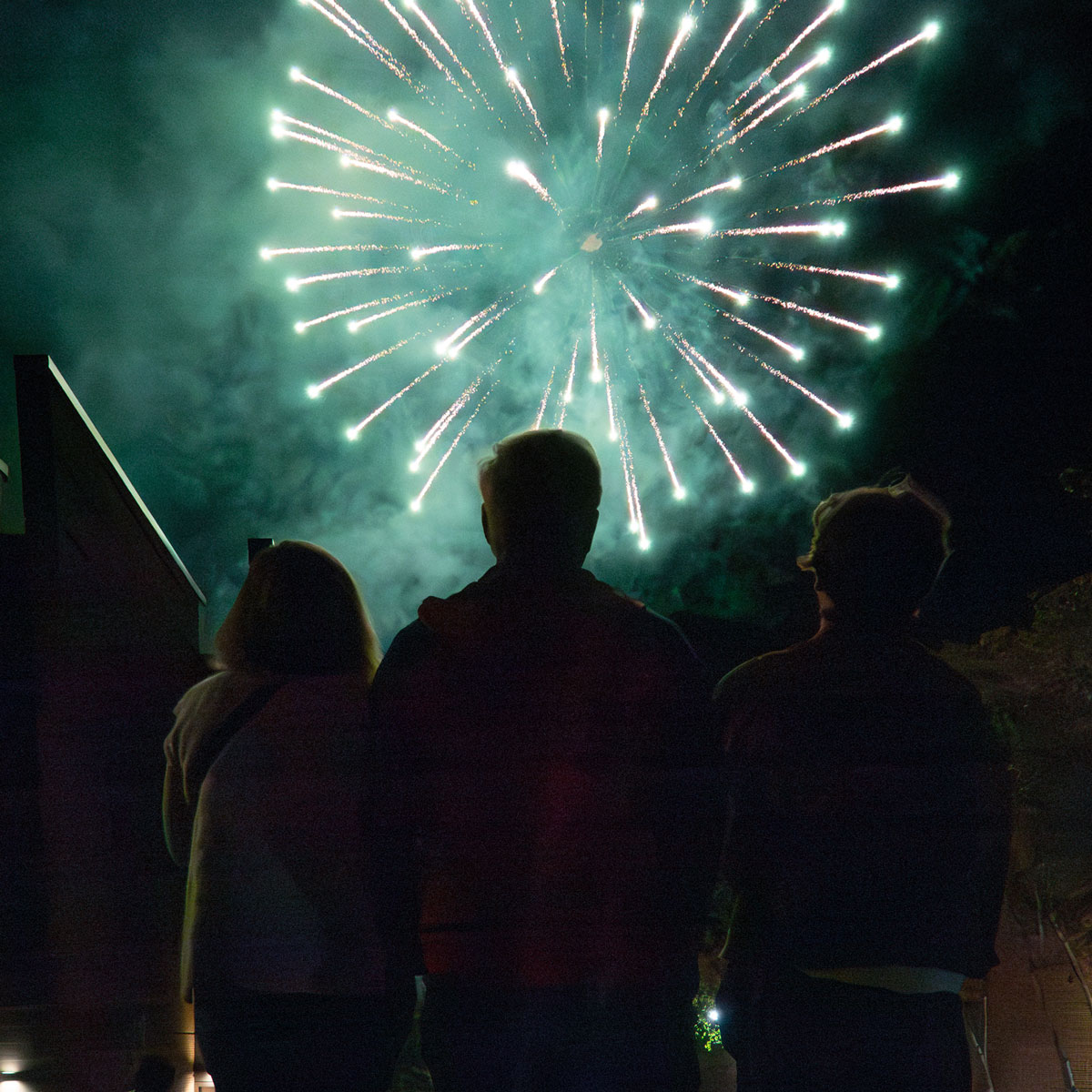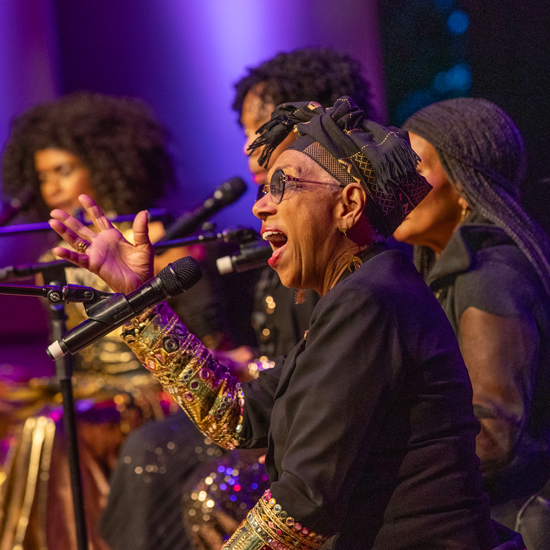Tang exhibition presents South Asian paintings
From the opulence of the Mughal court to stories of gods in human form, from battle scenes to intimate depictions of courtly love, historic South Asian paintings on display at the Frances Young Tang Teaching Museum and Art Gallery at Skidmore College offer visitors a chance to explore important cultural narratives that remain central to living belief systems on the Indian subcontinent.
Realms of Earth and Sky: Indian Painting from the Fifteenth to the Nineteenth Century opens January 31 and runs through May 17. The collection of 43 South Asian paintings from the University of Virginia’s Fralin Museum of Art spans multiple artistic and cultural traditions. Portraiture, religious and literary texts, ragamala paintings, and works from both Mughal and Rajput traditions are represented in meticulously rendered tableaux contained in the small scale of manuscript or album pages.
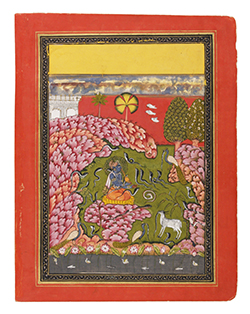
Leaf rom the Ragamala series, c. 1750
“There’s something about the small scale that makes them intensely powerful,” says Tang Assistant Director for Curatorial Affairs Rachel Seligman. “The size, the detail, the luscious colors create great intensity,” she says, noting that the Malloy Wing Galleries have been painted and lit to offer a feeling of warmth and intimacy for exploring works that originally would have been held in one’s hands.
A rich array of special events supporting the exhibition invites visitors to enjoy a festival with Indian food, music, and dance; workshops with artists who combine traditional painting with contemporary practice; and lectures organized as Skidmore’s annual Alfred Z. Solomon Residency. Highlighting the lecture series is a Feb. 5 talk by renowned artist and MacArthur Fellow Shahzia Sikander, whose work will be displayed on the Tang mezzanine.
The themes of Realms of Earth and Sky include the stylistic relationship between Mughal and Rajput paintings and the function of book illustration. Highlights include a rare sixteenth-century imperial Mughal painting by Khem Karan, a Rasikapriya illustration done by the famous seventeenth-century Mewari artist Sahibdin, and a portrait of the Guler ruler Raja Bishan Singh, attributed to Nainsukh.
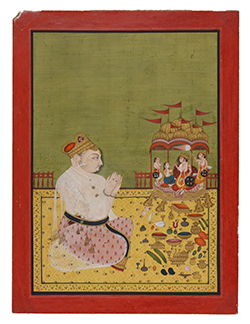
"A ruler worshiping Rama, Sita, Lakshamana,
and Hanuman," 18th–19th century
Skidmore art historian Saleema Waraich, who organized the Solomon lectures and is a specialist in South Asian art, notes that the exhibition introduces audiences to a very different style of painting: “South Asian artists were not interested, consciously, in realism as a pictorial mode of representation.” The works, she notes, illuminate important texts—“religious manuscripts, literary ones, and there are even several paintings that come out of representation of musical modes”—offering rich opportunities for interdisciplinary teaching and learning.
Particularly intriguing, says Waraich, is the way the exhibition provokes “a really exciting discussion around Hindu and Muslim interactions, particularly in a contemporary context, where in India Muslims are a minority and, depending on who is in the government, are more or less suppressed and marginalized.” These paintings offer a different narrative of interaction between the two groups, says Waraich, “one of being excited by what each other is doing, of wanting to learn more.”
This interaction can be seen in Ravana Visits the City of Asma, a City in Varuna’s Realm that Belongs to the Danava King Bali (Mughal, 1594), which depicts a Hindu epic in a work made for a Muslim Mughal ruler, and in Ruler Accepting a Sword from the Mughal Emperor Shah Jahan (Bundi, mid-seventeenth century) which shows a Rajput ruler paying respects to a Mughal one. Says Waraich, “It was not about conflict or hostility between Mughals and Rajput—or by extension Muslims and Hindus—but rather a really exciting exchange of ideas.”
The paintings, while small in scale, offer an extraordinary amount of meticulous detail. “People talk about using a single hair of a brush to make these fine exquisite lines,” says Waraich. “You can spend an hour looking and then go back and look at the same image and see something new.”
The following events at the Tang are free and open to the public:
- Thursday, Jan. 29, 5:30 p.m.—Preview Tour of Realms of Earth and Sky
Guided tour with exhibition contributor Krista Gulbransen, assistant professor of art history and visual culture studies at Whitman College.
-
Thursday, Feb. 5, 7:30 p.m.— Lecture by Shahzia Sikander
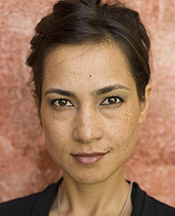
Shazia Sikander lecture Feb. 5
Internationally acclaimed Pakistani-born artist and MacArthur Fellow Shahzia Sikander will discuss her artistic practice of experimentation and disruption of historical Indo-Persian painting styles; presented by Skidmore College’s Department of Art History and the Tang Teaching Museum and supported by the Alfred Z. Solomon Residency Fund. -
Saturday, Feb. 7, 6:30–8 p.m.—Spring 2015 Opening Reception
Reception celebrating the Tang’s spring exhibitions, Realms of Earth and Sky: Indian Painting from the Fifteenth to the Nineteenth Century, Nicholas Krushenick: Electric Soup, and Elevator Music 28: Morton Subotnick—Silver Apples of the Moon.Wednesday, Feb. 25, 7–8:30 p.m. Ayurvedic Workshop
A workshop exploring this system of traditional Hindu medicine, with Skidmore Professor of Religion Eliza Kent. - Saturday, Feb. 28, 3–7 p.m.—Indian Festival
A celebration of Indian culture through food, dance, music, and art-making, co-organized with the Skidmore student club Hayat
- Thursday, April 2, 7 p.m.—Lecture by Molly Aitken and Dipti Khera
Two leading scholars of Rajput painting — Molly Aitken, associate professor of art history at the City College of New York, and Dipti Khera, assistant professor of art history at New York University — will lecture on pleasure in South Asian paintings; made possible by the Alfred Z. Solomon Residency Fund.
- Tuesday, April 14, noon—Tour of Realms of Earth and Sky
Guided tour with Rachel Seligman, Tang assistant director of curatorial affairs, and Saleema Waraich, Skidmore sssistant professor of art history.
- Thursday, April 16, 7:30 p.m.—Conversation with Talha Rathore and Hiba Schahbaz
Artists Talha Rathore and Hiba Schahbaz will speak about the traditional techniques in Realms of Earth and Sky and the ways in which they each have modernized and personalized the miniature tradition in their practice; made possible by the Alfred Z. Solomon Residency Fund.
- Friday, April 17, noon–2 p.m. and 2:30–4:30 p.m.—Miniature Painting Workshops with
Talha Rathore and Hiba Schahbaz
Free workshop with the artists. Reservations required; call 518-580-8080.
Realms of Earth and Sky is made possible by the Fralin Museum of Art at the University of Virginia. The exhibition is curated by Daniel J. Ehnbom, Fralin adjunct curator of South Asian Art and associate professor of South Asian art at the University of Virginia, with Krista Gulbransen, assistant professor of art history and visual culture studies at Whitman College and former Luzak-Lindner graduate fellow at the Fralin Museum.
A catalogue accompanies the exhibition and features essays and catalogue entries by curator Daniel Ehnbom and Krista Gulbransen.
Enhancing this exhibition and its catalogue is The Realms of Earth and Sky app, which was developed by the Fralin Museum and is available for free in Apple’s App Store (iPhone or iPad iOS7).
